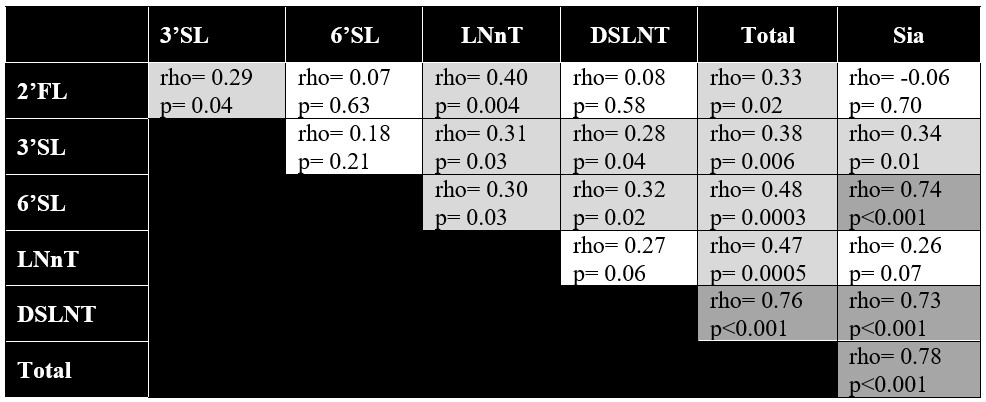Breastfeeding/Human Milk
Category: Abstract Submission
Breastfeeding/Human Milk II
425 - Associations of Human Milk Oligosaccharides with Brain Development in Very Preterm Infants
Sunday, April 24, 2022
3:30 PM - 6:00 PM US MT
Poster Number: 425
Publication Number: 425.302
Publication Number: 425.302
Margaret Ong, Boston Children's Hospital, Boston, MA, United States; Sara Cherkerzian, Brigham and Women's Hospital, Boston, MA, United States; Katherine Bell, Brigham and Women's Hospital, Boston, MA, United States; Annalee Furst, UCSD, San Diego, CA, United States; Terrie E. Inder, Harvard Medical School, Boston, MA, United States; Lars Bode, University of California San Diego, La Jolla, CA, United States; Mandy B. Belfort, Brigham and Women's Hospital, Harvard Medical School, Boston, MA, United States

Margaret L. Ong, MD
Clinical Fellow
Boston Children's Hospital
Boston, Massachusetts, United States
Presenting Author(s)
Background: Among very preterm infants, human milk feeding is associated with improved brain growth and neurodevelopmental outcomes. Mechanisms of neuroprotection are poorly understood but may involve non-nutrient bioactive factors such as human milk oligosaccharides (HMOs). Currently, little is known about relationships between HMO intake and brain injury, growth, and maturation during the critical developmental period in the neonatal intensive care unit (NICU).
Objective: To investigate associations between HMO composition of maternal milk and brain injury, size, and maturity at term-corrected age in very preterm infants. We hypothesized that higher concentration of specific HMOs would be associated with less brain injury, larger brain volume, and more mature white matter microstructure.
Design/Methods: We studied 51 infants < 32 weeks’ gestational age (GA) fed primarily maternal milk (≥75% at day 28). We measured HMO composition with high performance liquid chromatography on milk samples collected at two time points while the infant was in the NICU (T1, 13.0±7.7 days; T2, 66.4±24.8 days) and defined HMO exposure as mean area under the curve between measurements for: 1) concentration (µg/mL) of five specific HMOs; 2) HMO-bound sialic acid (nmol/mL); 3) total HMO (µg/mL). From brain MRI at term (post-menstrual age [PMA], 38.8±1.4 weeks), we quantified: 1) global brain abnormality score; 2) total and regional brain volumes; 3) white matter microstructure (fractional anisotropy [FA] in the posterior limbs of the internal capsule [PLIC] and corpus callosum [CC]). We used linear mixed effects models to estimate associations between HMO exposure ( >75th vs ≤75th percentile) and each outcome, adjusting for GA, sex, birth weight z-score, PMA at MRI, and intrafamilial correlation among twins.
Results: Mean birth weight was 1026±378g; GA, 28.1±2.4 weeks [Table 1]. Specific HMO concentrations were positively correlated with each other [Table 2]. Higher 3’SL, DSLNT, and total HMO were associated with higher FA-CC (1.0% higher mean FA in >75th vs ≤75th percentile, 95% CI (0.1, 2.0) for 3’SL; 0.8%, 95% CI (0.03, 1.5) for DSLNT; 0.8%, 95% CI (0.03, 1.6) for total HMO). Higher 6’SL exposure was associated with smaller hippocampus volume (0.4cc lower in >75th vs ≤75th percentile, 95% CI (-0.6, -0.3)) [Table 3].Conclusion(s): Exposure to higher concentrations of specific (3’SL, DSLNT) and total HMOs may benefit white matter development in very preterm infants. However, exposure to higher 6’SL concentration was associated with smaller hippocampus volume, suggesting heterogeneity of effects among HMOs.
Table 1: Participant Characteristics (n=51).jpg) Data are expressed as mean ± SD or n (%). Z-scores for anthropometric measurements are based on Fenton 2013. Global brain abnormality scores are based on Kidokoro 2013. NEC: necrotizing enterocolitis. FA: fractional anisotropy. PLIC: posterior limb of the internal capsule. CC: corpus callosum.
Data are expressed as mean ± SD or n (%). Z-scores for anthropometric measurements are based on Fenton 2013. Global brain abnormality scores are based on Kidokoro 2013. NEC: necrotizing enterocolitis. FA: fractional anisotropy. PLIC: posterior limb of the internal capsule. CC: corpus callosum.
Table 2: Spearman correlations among concentrations of HMOs in maternal milk fed to very preterm infants (n=51) Mean area under the curve for concentrations of specific and total HMOs and HMO-bound sialic acid were analyzed using Spearman’s correlation. Box colors represent strength of correlation, with darker gray depicting stronger correlations. 2’FL: 2’fucosyllactose. 3’SL: 3’sialyllactose. 6’SL: 6’sialyllactose. LNnT: lacto-N-neotetraose. DSLNT: disialyllacto-N-tetraose. Sia: HMO-bound sialic acid.
Mean area under the curve for concentrations of specific and total HMOs and HMO-bound sialic acid were analyzed using Spearman’s correlation. Box colors represent strength of correlation, with darker gray depicting stronger correlations. 2’FL: 2’fucosyllactose. 3’SL: 3’sialyllactose. 6’SL: 6’sialyllactose. LNnT: lacto-N-neotetraose. DSLNT: disialyllacto-N-tetraose. Sia: HMO-bound sialic acid.
Objective: To investigate associations between HMO composition of maternal milk and brain injury, size, and maturity at term-corrected age in very preterm infants. We hypothesized that higher concentration of specific HMOs would be associated with less brain injury, larger brain volume, and more mature white matter microstructure.
Design/Methods: We studied 51 infants < 32 weeks’ gestational age (GA) fed primarily maternal milk (≥75% at day 28). We measured HMO composition with high performance liquid chromatography on milk samples collected at two time points while the infant was in the NICU (T1, 13.0±7.7 days; T2, 66.4±24.8 days) and defined HMO exposure as mean area under the curve between measurements for: 1) concentration (µg/mL) of five specific HMOs; 2) HMO-bound sialic acid (nmol/mL); 3) total HMO (µg/mL). From brain MRI at term (post-menstrual age [PMA], 38.8±1.4 weeks), we quantified: 1) global brain abnormality score; 2) total and regional brain volumes; 3) white matter microstructure (fractional anisotropy [FA] in the posterior limbs of the internal capsule [PLIC] and corpus callosum [CC]). We used linear mixed effects models to estimate associations between HMO exposure ( >75th vs ≤75th percentile) and each outcome, adjusting for GA, sex, birth weight z-score, PMA at MRI, and intrafamilial correlation among twins.
Results: Mean birth weight was 1026±378g; GA, 28.1±2.4 weeks [Table 1]. Specific HMO concentrations were positively correlated with each other [Table 2]. Higher 3’SL, DSLNT, and total HMO were associated with higher FA-CC (1.0% higher mean FA in >75th vs ≤75th percentile, 95% CI (0.1, 2.0) for 3’SL; 0.8%, 95% CI (0.03, 1.5) for DSLNT; 0.8%, 95% CI (0.03, 1.6) for total HMO). Higher 6’SL exposure was associated with smaller hippocampus volume (0.4cc lower in >75th vs ≤75th percentile, 95% CI (-0.6, -0.3)) [Table 3].Conclusion(s): Exposure to higher concentrations of specific (3’SL, DSLNT) and total HMOs may benefit white matter development in very preterm infants. However, exposure to higher 6’SL concentration was associated with smaller hippocampus volume, suggesting heterogeneity of effects among HMOs.
Table 1: Participant Characteristics (n=51)
.jpg) Data are expressed as mean ± SD or n (%). Z-scores for anthropometric measurements are based on Fenton 2013. Global brain abnormality scores are based on Kidokoro 2013. NEC: necrotizing enterocolitis. FA: fractional anisotropy. PLIC: posterior limb of the internal capsule. CC: corpus callosum.
Data are expressed as mean ± SD or n (%). Z-scores for anthropometric measurements are based on Fenton 2013. Global brain abnormality scores are based on Kidokoro 2013. NEC: necrotizing enterocolitis. FA: fractional anisotropy. PLIC: posterior limb of the internal capsule. CC: corpus callosum.Table 2: Spearman correlations among concentrations of HMOs in maternal milk fed to very preterm infants (n=51)
 Mean area under the curve for concentrations of specific and total HMOs and HMO-bound sialic acid were analyzed using Spearman’s correlation. Box colors represent strength of correlation, with darker gray depicting stronger correlations. 2’FL: 2’fucosyllactose. 3’SL: 3’sialyllactose. 6’SL: 6’sialyllactose. LNnT: lacto-N-neotetraose. DSLNT: disialyllacto-N-tetraose. Sia: HMO-bound sialic acid.
Mean area under the curve for concentrations of specific and total HMOs and HMO-bound sialic acid were analyzed using Spearman’s correlation. Box colors represent strength of correlation, with darker gray depicting stronger correlations. 2’FL: 2’fucosyllactose. 3’SL: 3’sialyllactose. 6’SL: 6’sialyllactose. LNnT: lacto-N-neotetraose. DSLNT: disialyllacto-N-tetraose. Sia: HMO-bound sialic acid.